University Report: Batteries and Wireless Charging of Electric Cars
VerifiedAdded on 2020/05/08
|33
|10248
|216
Report
AI Summary
This report provides a comprehensive overview of batteries and wireless charging technologies for electric cars. It begins with an introduction to batteries and wireless charging, followed by a literature review that explores the overview of the topic, benefits, and limitations of wireless charging, the impact of wired and dynamic wireless charging on electric vehicles, and charging station location issues. The report discusses research design, including research questions, related work, and design considerations. The report also explores various aspects of wireless charging, including inductive power transfer (IPT), static and dynamic charging methods, and their implications for electric vehicles. It also covers the environmental benefits and challenges associated with electric vehicle adoption, including a discussion of eco-routing strategies. The report concludes by emphasizing the importance of wireless charging for the future of electric vehicles, highlighting its potential to improve convenience, efficiency, and energy sustainability. The report is a student's research on the subject.
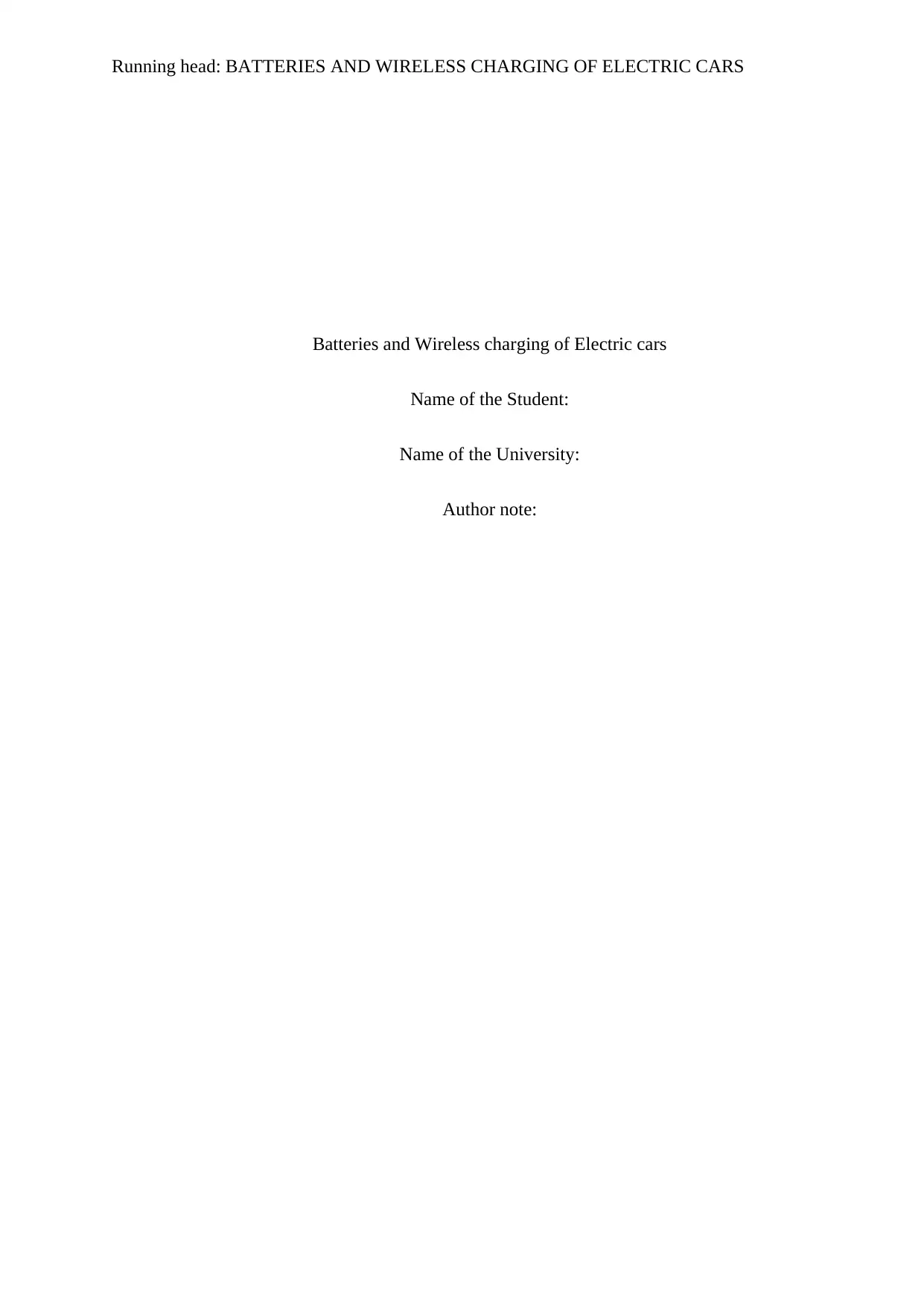
Running head: BATTERIES AND WIRELESS CHARGING OF ELECTRIC CARS
Batteries and Wireless charging of Electric cars
Name of the Student:
Name of the University:
Author note:
Batteries and Wireless charging of Electric cars
Name of the Student:
Name of the University:
Author note:
Paraphrase This Document
Need a fresh take? Get an instant paraphrase of this document with our AI Paraphraser
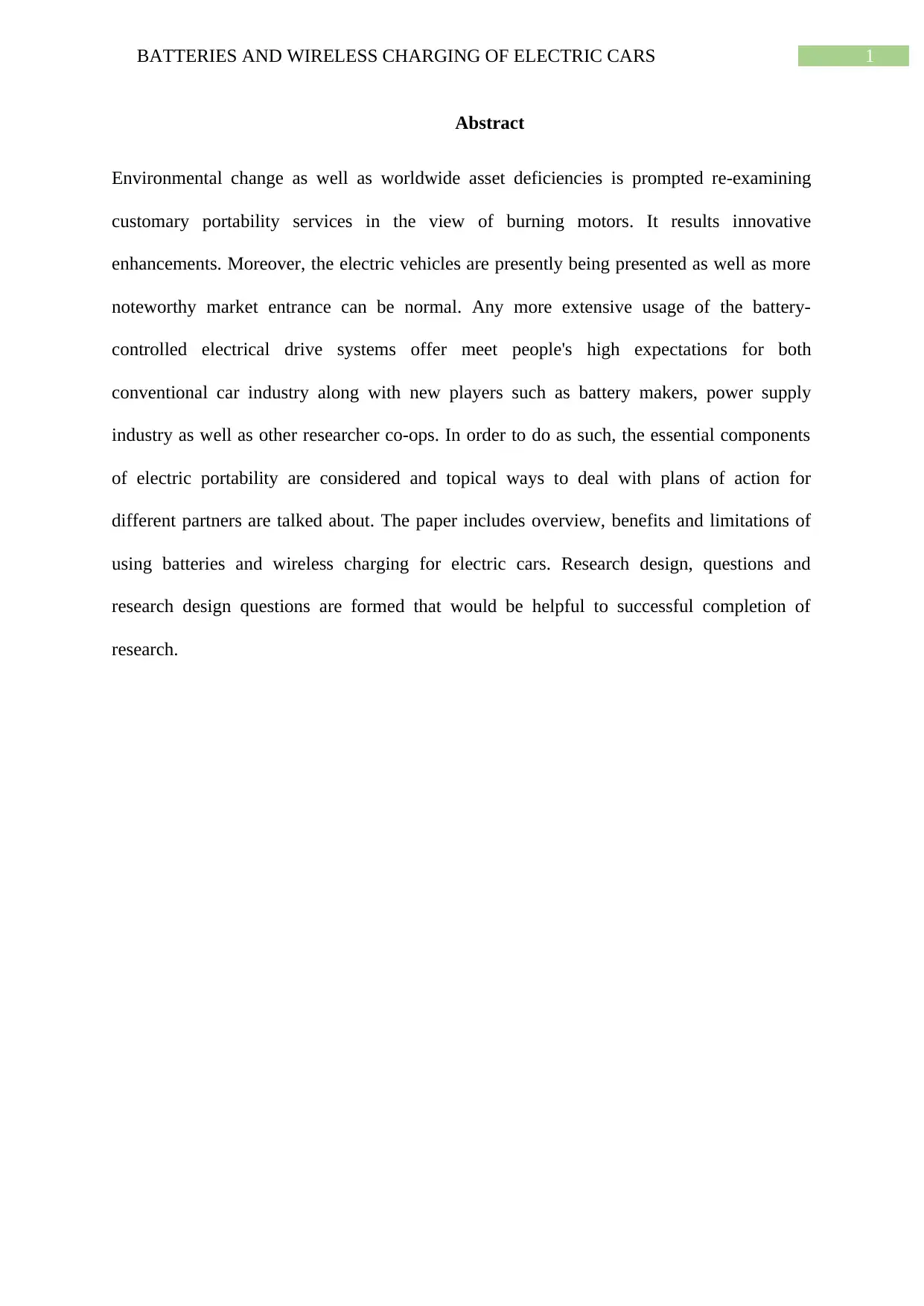
1BATTERIES AND WIRELESS CHARGING OF ELECTRIC CARS
Abstract
Environmental change as well as worldwide asset deficiencies is prompted re-examining
customary portability services in the view of burning motors. It results innovative
enhancements. Moreover, the electric vehicles are presently being presented as well as more
noteworthy market entrance can be normal. Any more extensive usage of the battery-
controlled electrical drive systems offer meet people's high expectations for both
conventional car industry along with new players such as battery makers, power supply
industry as well as other researcher co-ops. In order to do as such, the essential components
of electric portability are considered and topical ways to deal with plans of action for
different partners are talked about. The paper includes overview, benefits and limitations of
using batteries and wireless charging for electric cars. Research design, questions and
research design questions are formed that would be helpful to successful completion of
research.
Abstract
Environmental change as well as worldwide asset deficiencies is prompted re-examining
customary portability services in the view of burning motors. It results innovative
enhancements. Moreover, the electric vehicles are presently being presented as well as more
noteworthy market entrance can be normal. Any more extensive usage of the battery-
controlled electrical drive systems offer meet people's high expectations for both
conventional car industry along with new players such as battery makers, power supply
industry as well as other researcher co-ops. In order to do as such, the essential components
of electric portability are considered and topical ways to deal with plans of action for
different partners are talked about. The paper includes overview, benefits and limitations of
using batteries and wireless charging for electric cars. Research design, questions and
research design questions are formed that would be helpful to successful completion of
research.
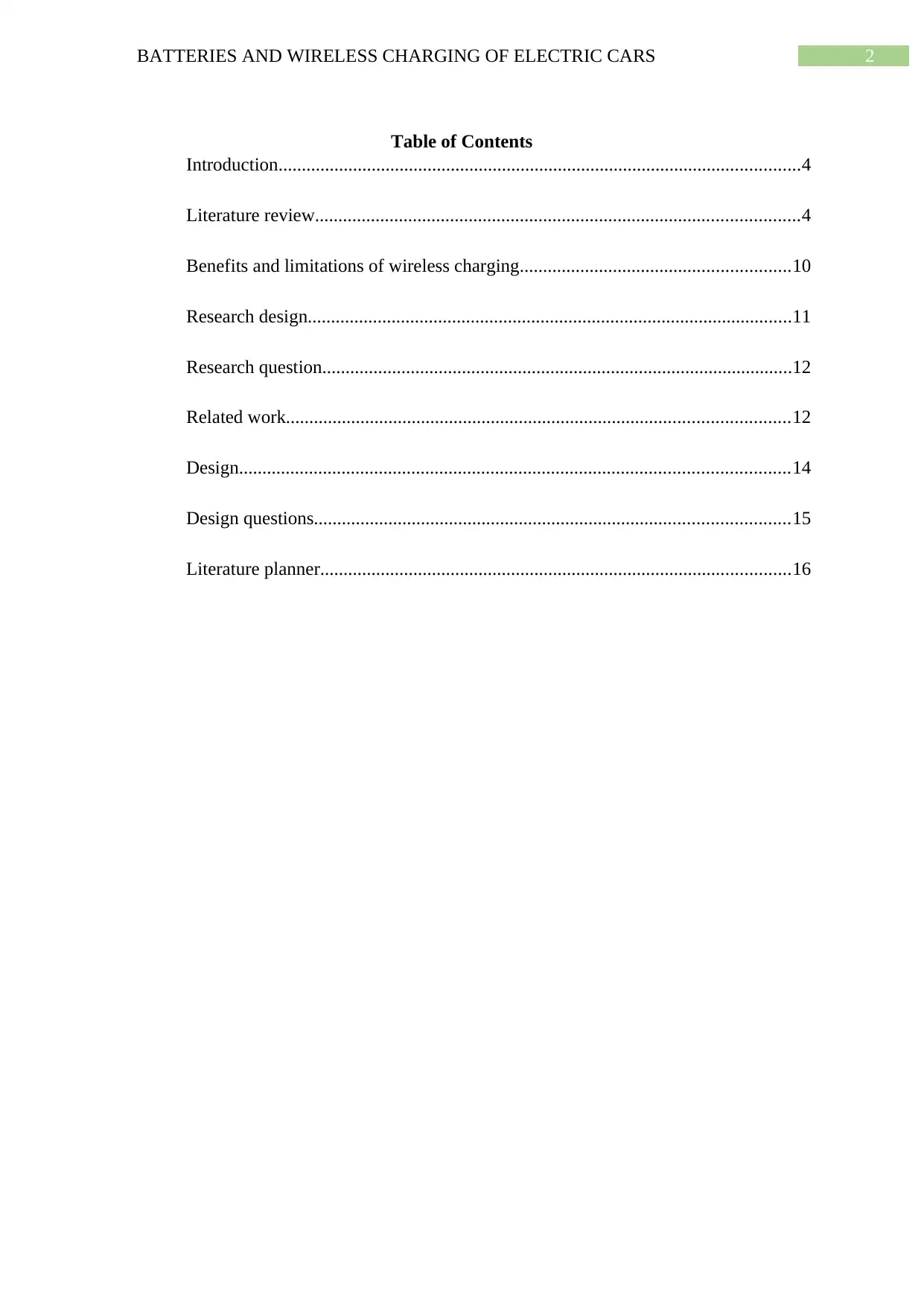
2BATTERIES AND WIRELESS CHARGING OF ELECTRIC CARS
Table of Contents
Introduction................................................................................................................4
Literature review........................................................................................................4
Benefits and limitations of wireless charging..........................................................10
Research design........................................................................................................11
Research question.....................................................................................................12
Related work............................................................................................................12
Design......................................................................................................................14
Design questions......................................................................................................15
Literature planner.....................................................................................................16
Table of Contents
Introduction................................................................................................................4
Literature review........................................................................................................4
Benefits and limitations of wireless charging..........................................................10
Research design........................................................................................................11
Research question.....................................................................................................12
Related work............................................................................................................12
Design......................................................................................................................14
Design questions......................................................................................................15
Literature planner.....................................................................................................16
⊘ This is a preview!⊘
Do you want full access?
Subscribe today to unlock all pages.

Trusted by 1+ million students worldwide
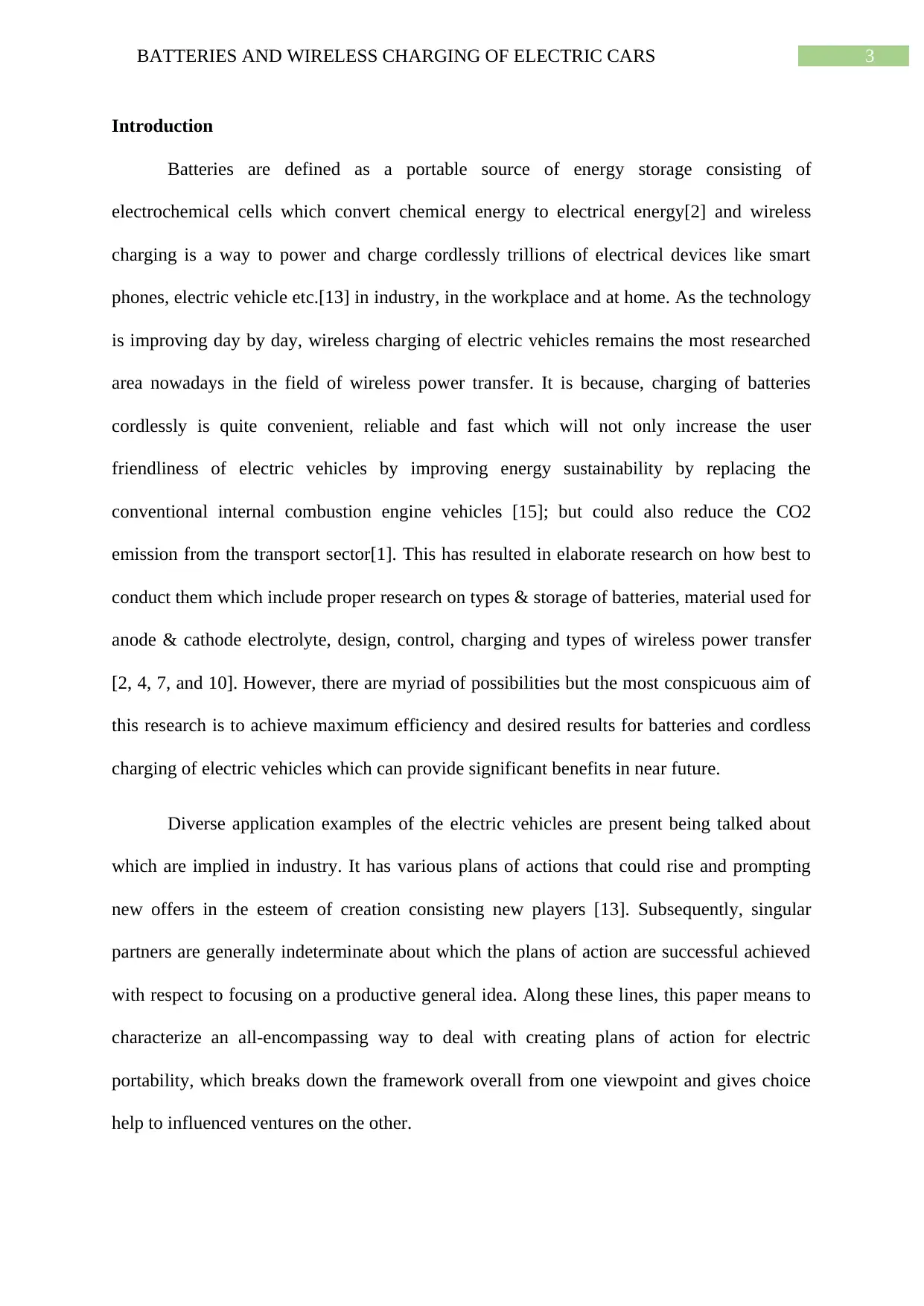
3BATTERIES AND WIRELESS CHARGING OF ELECTRIC CARS
Introduction
Batteries are defined as a portable source of energy storage consisting of
electrochemical cells which convert chemical energy to electrical energy[2] and wireless
charging is a way to power and charge cordlessly trillions of electrical devices like smart
phones, electric vehicle etc.[13] in industry, in the workplace and at home. As the technology
is improving day by day, wireless charging of electric vehicles remains the most researched
area nowadays in the field of wireless power transfer. It is because, charging of batteries
cordlessly is quite convenient, reliable and fast which will not only increase the user
friendliness of electric vehicles by improving energy sustainability by replacing the
conventional internal combustion engine vehicles [15]; but could also reduce the CO2
emission from the transport sector[1]. This has resulted in elaborate research on how best to
conduct them which include proper research on types & storage of batteries, material used for
anode & cathode electrolyte, design, control, charging and types of wireless power transfer
[2, 4, 7, and 10]. However, there are myriad of possibilities but the most conspicuous aim of
this research is to achieve maximum efficiency and desired results for batteries and cordless
charging of electric vehicles which can provide significant benefits in near future.
Diverse application examples of the electric vehicles are present being talked about
which are implied in industry. It has various plans of actions that could rise and prompting
new offers in the esteem of creation consisting new players [13]. Subsequently, singular
partners are generally indeterminate about which the plans of action are successful achieved
with respect to focusing on a productive general idea. Along these lines, this paper means to
characterize an all-encompassing way to deal with creating plans of action for electric
portability, which breaks down the framework overall from one viewpoint and gives choice
help to influenced ventures on the other.
Introduction
Batteries are defined as a portable source of energy storage consisting of
electrochemical cells which convert chemical energy to electrical energy[2] and wireless
charging is a way to power and charge cordlessly trillions of electrical devices like smart
phones, electric vehicle etc.[13] in industry, in the workplace and at home. As the technology
is improving day by day, wireless charging of electric vehicles remains the most researched
area nowadays in the field of wireless power transfer. It is because, charging of batteries
cordlessly is quite convenient, reliable and fast which will not only increase the user
friendliness of electric vehicles by improving energy sustainability by replacing the
conventional internal combustion engine vehicles [15]; but could also reduce the CO2
emission from the transport sector[1]. This has resulted in elaborate research on how best to
conduct them which include proper research on types & storage of batteries, material used for
anode & cathode electrolyte, design, control, charging and types of wireless power transfer
[2, 4, 7, and 10]. However, there are myriad of possibilities but the most conspicuous aim of
this research is to achieve maximum efficiency and desired results for batteries and cordless
charging of electric vehicles which can provide significant benefits in near future.
Diverse application examples of the electric vehicles are present being talked about
which are implied in industry. It has various plans of actions that could rise and prompting
new offers in the esteem of creation consisting new players [13]. Subsequently, singular
partners are generally indeterminate about which the plans of action are successful achieved
with respect to focusing on a productive general idea. Along these lines, this paper means to
characterize an all-encompassing way to deal with creating plans of action for electric
portability, which breaks down the framework overall from one viewpoint and gives choice
help to influenced ventures on the other.
Paraphrase This Document
Need a fresh take? Get an instant paraphrase of this document with our AI Paraphraser
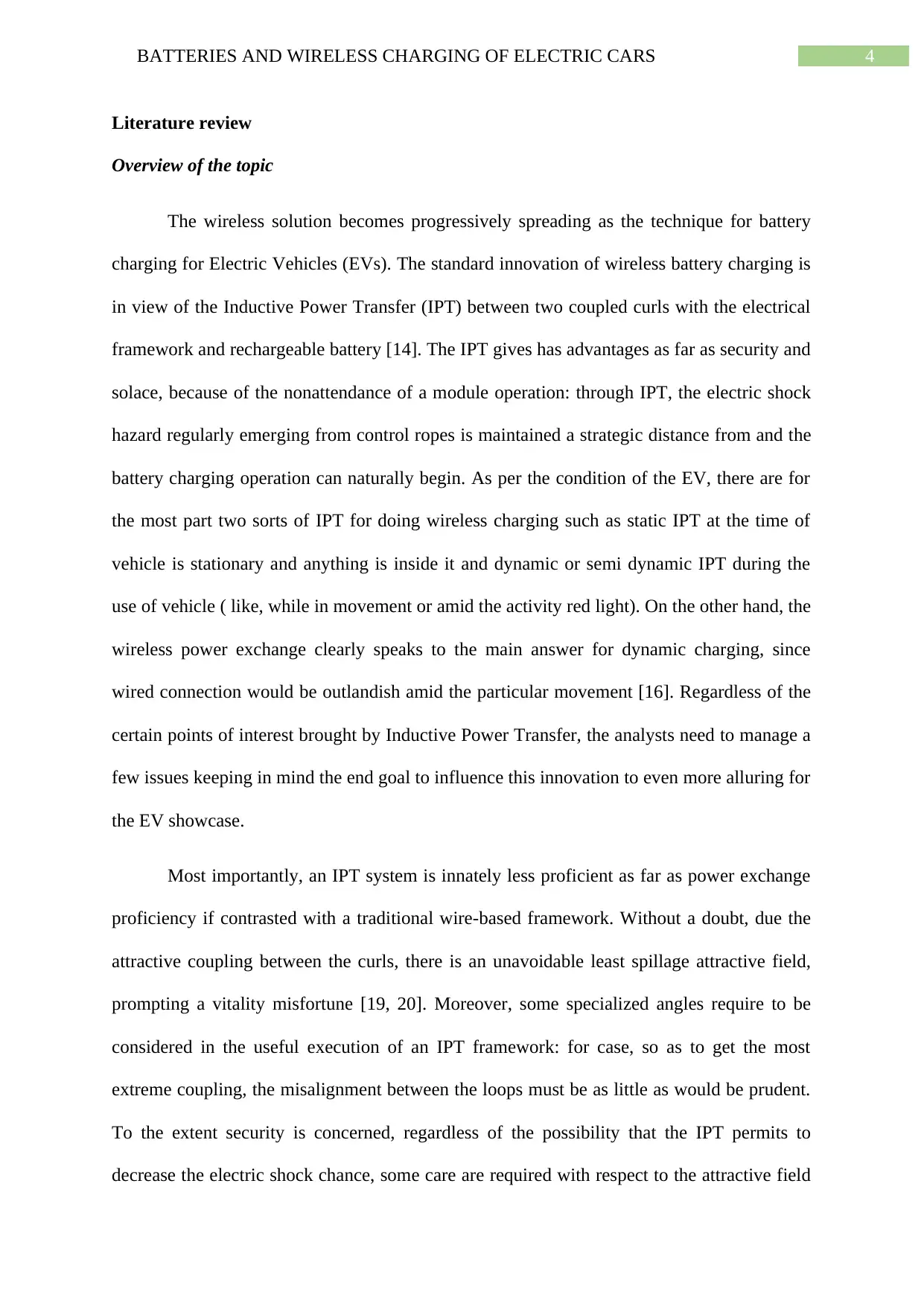
4BATTERIES AND WIRELESS CHARGING OF ELECTRIC CARS
Literature review
Overview of the topic
The wireless solution becomes progressively spreading as the technique for battery
charging for Electric Vehicles (EVs). The standard innovation of wireless battery charging is
in view of the Inductive Power Transfer (IPT) between two coupled curls with the electrical
framework and rechargeable battery [14]. The IPT gives has advantages as far as security and
solace, because of the nonattendance of a module operation: through IPT, the electric shock
hazard regularly emerging from control ropes is maintained a strategic distance from and the
battery charging operation can naturally begin. As per the condition of the EV, there are for
the most part two sorts of IPT for doing wireless charging such as static IPT at the time of
vehicle is stationary and anything is inside it and dynamic or semi dynamic IPT during the
use of vehicle ( like, while in movement or amid the activity red light). On the other hand, the
wireless power exchange clearly speaks to the main answer for dynamic charging, since
wired connection would be outlandish amid the particular movement [16]. Regardless of the
certain points of interest brought by Inductive Power Transfer, the analysts need to manage a
few issues keeping in mind the end goal to influence this innovation to even more alluring for
the EV showcase.
Most importantly, an IPT system is innately less proficient as far as power exchange
proficiency if contrasted with a traditional wire-based framework. Without a doubt, due the
attractive coupling between the curls, there is an unavoidable least spillage attractive field,
prompting a vitality misfortune [19, 20]. Moreover, some specialized angles require to be
considered in the useful execution of an IPT framework: for case, so as to get the most
extreme coupling, the misalignment between the loops must be as little as would be prudent.
To the extent security is concerned, regardless of the possibility that the IPT permits to
decrease the electric shock chance, some care are required with respect to the attractive field
Literature review
Overview of the topic
The wireless solution becomes progressively spreading as the technique for battery
charging for Electric Vehicles (EVs). The standard innovation of wireless battery charging is
in view of the Inductive Power Transfer (IPT) between two coupled curls with the electrical
framework and rechargeable battery [14]. The IPT gives has advantages as far as security and
solace, because of the nonattendance of a module operation: through IPT, the electric shock
hazard regularly emerging from control ropes is maintained a strategic distance from and the
battery charging operation can naturally begin. As per the condition of the EV, there are for
the most part two sorts of IPT for doing wireless charging such as static IPT at the time of
vehicle is stationary and anything is inside it and dynamic or semi dynamic IPT during the
use of vehicle ( like, while in movement or amid the activity red light). On the other hand, the
wireless power exchange clearly speaks to the main answer for dynamic charging, since
wired connection would be outlandish amid the particular movement [16]. Regardless of the
certain points of interest brought by Inductive Power Transfer, the analysts need to manage a
few issues keeping in mind the end goal to influence this innovation to even more alluring for
the EV showcase.
Most importantly, an IPT system is innately less proficient as far as power exchange
proficiency if contrasted with a traditional wire-based framework. Without a doubt, due the
attractive coupling between the curls, there is an unavoidable least spillage attractive field,
prompting a vitality misfortune [19, 20]. Moreover, some specialized angles require to be
considered in the useful execution of an IPT framework: for case, so as to get the most
extreme coupling, the misalignment between the loops must be as little as would be prudent.
To the extent security is concerned, regardless of the possibility that the IPT permits to
decrease the electric shock chance, some care are required with respect to the attractive field
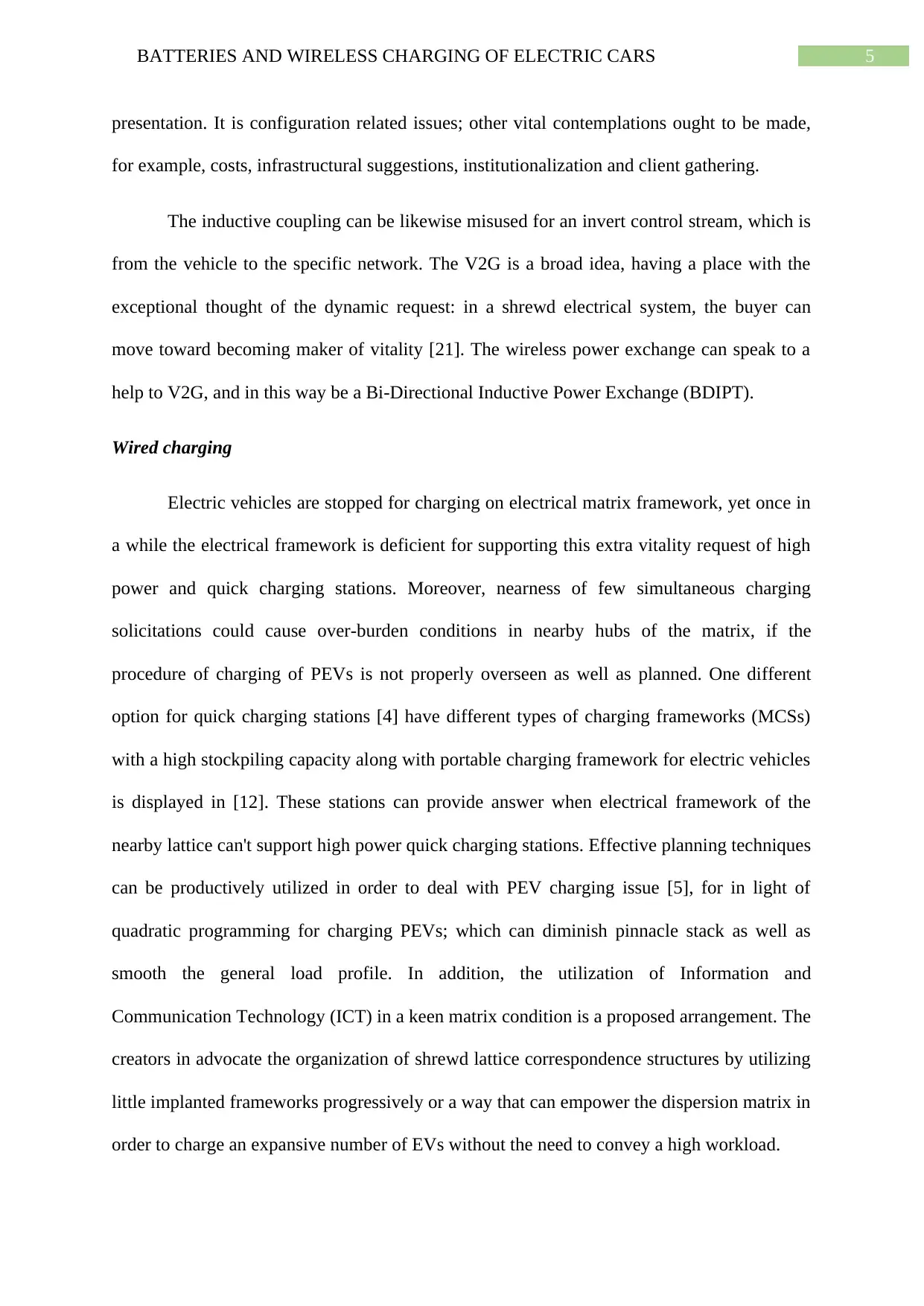
5BATTERIES AND WIRELESS CHARGING OF ELECTRIC CARS
presentation. It is configuration related issues; other vital contemplations ought to be made,
for example, costs, infrastructural suggestions, institutionalization and client gathering.
The inductive coupling can be likewise misused for an invert control stream, which is
from the vehicle to the specific network. The V2G is a broad idea, having a place with the
exceptional thought of the dynamic request: in a shrewd electrical system, the buyer can
move toward becoming maker of vitality [21]. The wireless power exchange can speak to a
help to V2G, and in this way be a Bi-Directional Inductive Power Exchange (BDIPT).
Wired charging
Electric vehicles are stopped for charging on electrical matrix framework, yet once in
a while the electrical framework is deficient for supporting this extra vitality request of high
power and quick charging stations. Moreover, nearness of few simultaneous charging
solicitations could cause over-burden conditions in nearby hubs of the matrix, if the
procedure of charging of PEVs is not properly overseen as well as planned. One different
option for quick charging stations [4] have different types of charging frameworks (MCSs)
with a high stockpiling capacity along with portable charging framework for electric vehicles
is displayed in [12]. These stations can provide answer when electrical framework of the
nearby lattice can't support high power quick charging stations. Effective planning techniques
can be productively utilized in order to deal with PEV charging issue [5], for in light of
quadratic programming for charging PEVs; which can diminish pinnacle stack as well as
smooth the general load profile. In addition, the utilization of Information and
Communication Technology (ICT) in a keen matrix condition is a proposed arrangement. The
creators in advocate the organization of shrewd lattice correspondence structures by utilizing
little implanted frameworks progressively or a way that can empower the dispersion matrix in
order to charge an expansive number of EVs without the need to convey a high workload.
presentation. It is configuration related issues; other vital contemplations ought to be made,
for example, costs, infrastructural suggestions, institutionalization and client gathering.
The inductive coupling can be likewise misused for an invert control stream, which is
from the vehicle to the specific network. The V2G is a broad idea, having a place with the
exceptional thought of the dynamic request: in a shrewd electrical system, the buyer can
move toward becoming maker of vitality [21]. The wireless power exchange can speak to a
help to V2G, and in this way be a Bi-Directional Inductive Power Exchange (BDIPT).
Wired charging
Electric vehicles are stopped for charging on electrical matrix framework, yet once in
a while the electrical framework is deficient for supporting this extra vitality request of high
power and quick charging stations. Moreover, nearness of few simultaneous charging
solicitations could cause over-burden conditions in nearby hubs of the matrix, if the
procedure of charging of PEVs is not properly overseen as well as planned. One different
option for quick charging stations [4] have different types of charging frameworks (MCSs)
with a high stockpiling capacity along with portable charging framework for electric vehicles
is displayed in [12]. These stations can provide answer when electrical framework of the
nearby lattice can't support high power quick charging stations. Effective planning techniques
can be productively utilized in order to deal with PEV charging issue [5], for in light of
quadratic programming for charging PEVs; which can diminish pinnacle stack as well as
smooth the general load profile. In addition, the utilization of Information and
Communication Technology (ICT) in a keen matrix condition is a proposed arrangement. The
creators in advocate the organization of shrewd lattice correspondence structures by utilizing
little implanted frameworks progressively or a way that can empower the dispersion matrix in
order to charge an expansive number of EVs without the need to convey a high workload.
⊘ This is a preview!⊘
Do you want full access?
Subscribe today to unlock all pages.

Trusted by 1+ million students worldwide
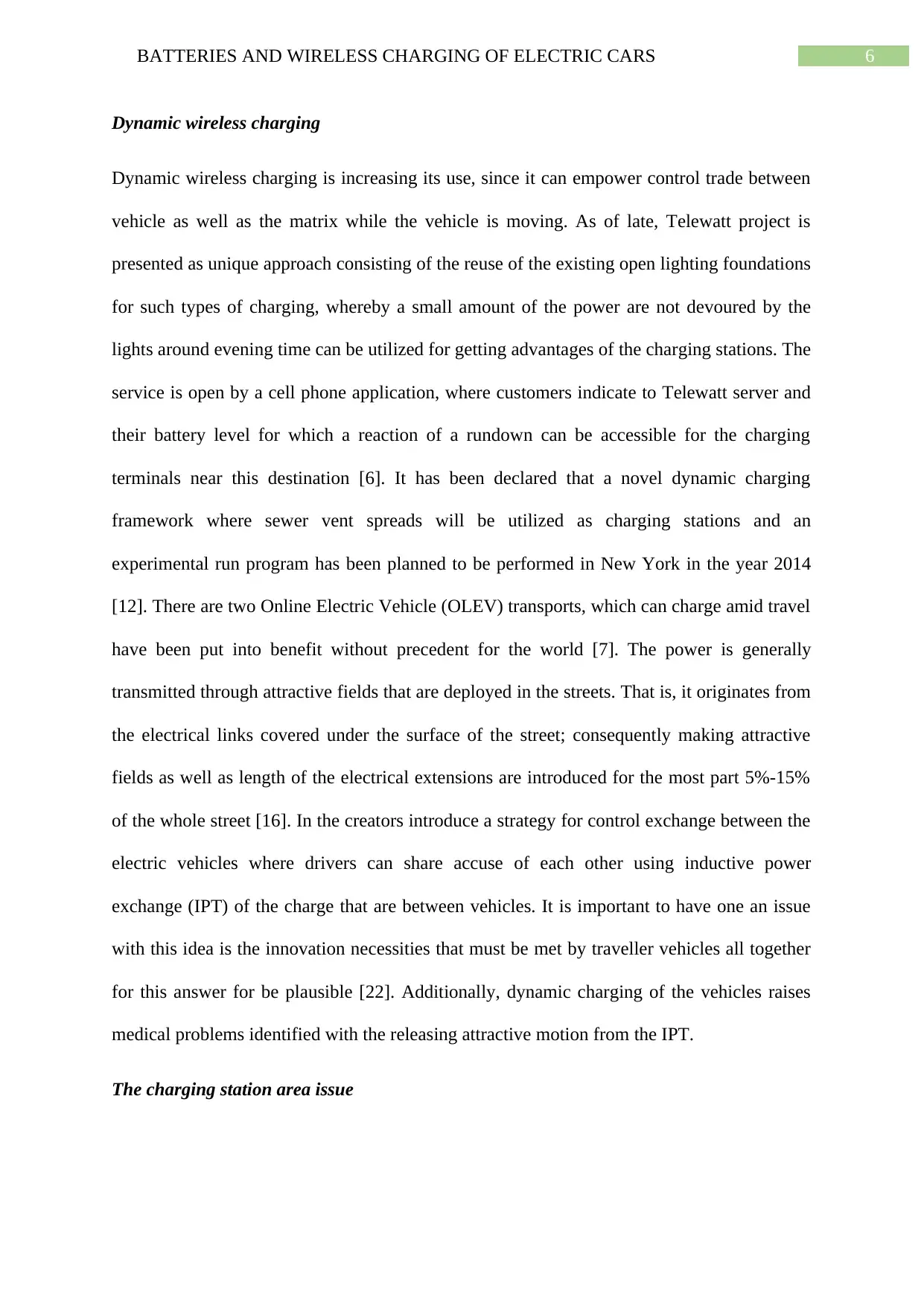
6BATTERIES AND WIRELESS CHARGING OF ELECTRIC CARS
Dynamic wireless charging
Dynamic wireless charging is increasing its use, since it can empower control trade between
vehicle as well as the matrix while the vehicle is moving. As of late, Telewatt project is
presented as unique approach consisting of the reuse of the existing open lighting foundations
for such types of charging, whereby a small amount of the power are not devoured by the
lights around evening time can be utilized for getting advantages of the charging stations. The
service is open by a cell phone application, where customers indicate to Telewatt server and
their battery level for which a reaction of a rundown can be accessible for the charging
terminals near this destination [6]. It has been declared that a novel dynamic charging
framework where sewer vent spreads will be utilized as charging stations and an
experimental run program has been planned to be performed in New York in the year 2014
[12]. There are two Online Electric Vehicle (OLEV) transports, which can charge amid travel
have been put into benefit without precedent for the world [7]. The power is generally
transmitted through attractive fields that are deployed in the streets. That is, it originates from
the electrical links covered under the surface of the street; consequently making attractive
fields as well as length of the electrical extensions are introduced for the most part 5%-15%
of the whole street [16]. In the creators introduce a strategy for control exchange between the
electric vehicles where drivers can share accuse of each other using inductive power
exchange (IPT) of the charge that are between vehicles. It is important to have one an issue
with this idea is the innovation necessities that must be met by traveller vehicles all together
for this answer for be plausible [22]. Additionally, dynamic charging of the vehicles raises
medical problems identified with the releasing attractive motion from the IPT.
The charging station area issue
Dynamic wireless charging
Dynamic wireless charging is increasing its use, since it can empower control trade between
vehicle as well as the matrix while the vehicle is moving. As of late, Telewatt project is
presented as unique approach consisting of the reuse of the existing open lighting foundations
for such types of charging, whereby a small amount of the power are not devoured by the
lights around evening time can be utilized for getting advantages of the charging stations. The
service is open by a cell phone application, where customers indicate to Telewatt server and
their battery level for which a reaction of a rundown can be accessible for the charging
terminals near this destination [6]. It has been declared that a novel dynamic charging
framework where sewer vent spreads will be utilized as charging stations and an
experimental run program has been planned to be performed in New York in the year 2014
[12]. There are two Online Electric Vehicle (OLEV) transports, which can charge amid travel
have been put into benefit without precedent for the world [7]. The power is generally
transmitted through attractive fields that are deployed in the streets. That is, it originates from
the electrical links covered under the surface of the street; consequently making attractive
fields as well as length of the electrical extensions are introduced for the most part 5%-15%
of the whole street [16]. In the creators introduce a strategy for control exchange between the
electric vehicles where drivers can share accuse of each other using inductive power
exchange (IPT) of the charge that are between vehicles. It is important to have one an issue
with this idea is the innovation necessities that must be met by traveller vehicles all together
for this answer for be plausible [22]. Additionally, dynamic charging of the vehicles raises
medical problems identified with the releasing attractive motion from the IPT.
The charging station area issue
Paraphrase This Document
Need a fresh take? Get an instant paraphrase of this document with our AI Paraphraser
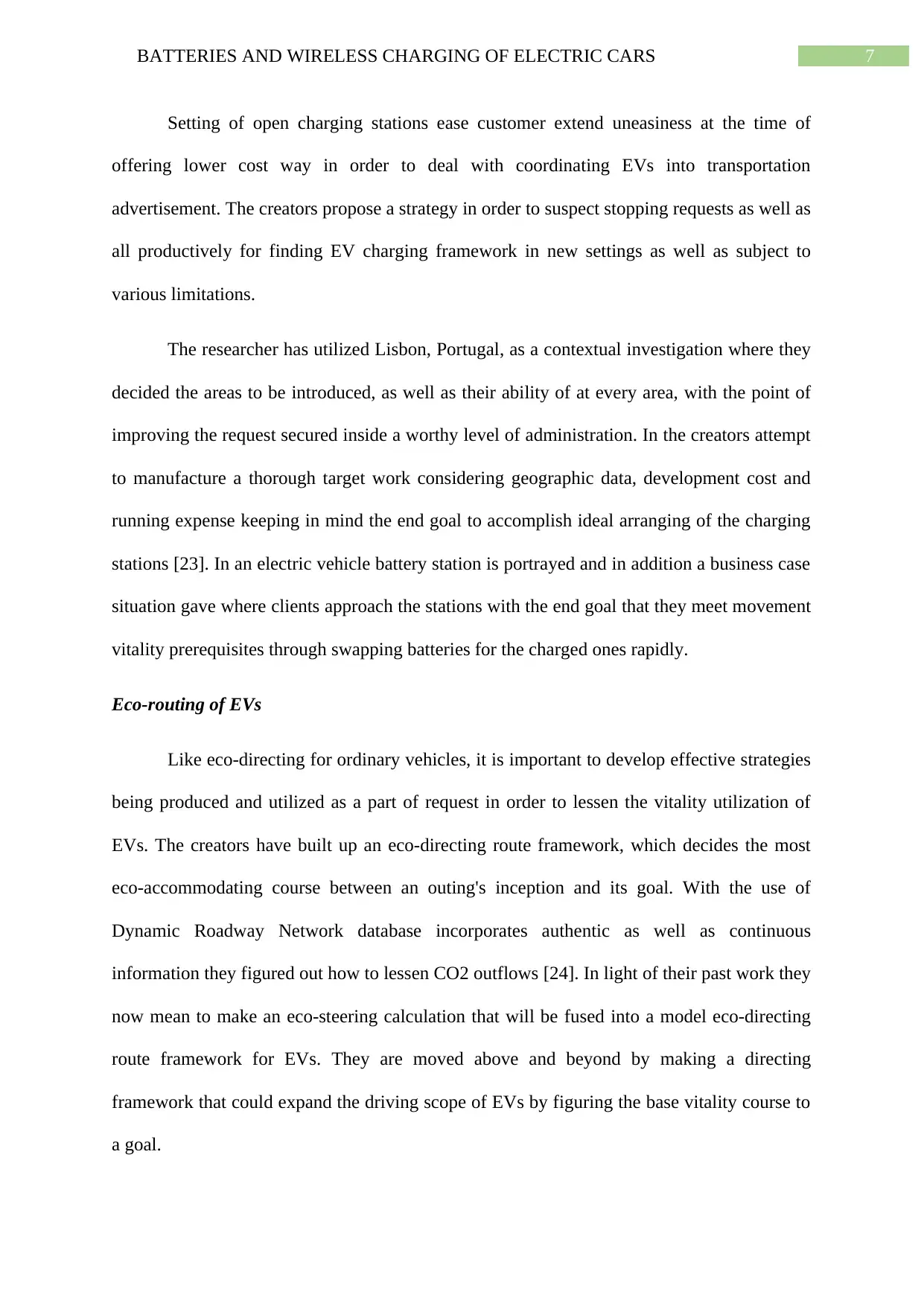
7BATTERIES AND WIRELESS CHARGING OF ELECTRIC CARS
Setting of open charging stations ease customer extend uneasiness at the time of
offering lower cost way in order to deal with coordinating EVs into transportation
advertisement. The creators propose a strategy in order to suspect stopping requests as well as
all productively for finding EV charging framework in new settings as well as subject to
various limitations.
The researcher has utilized Lisbon, Portugal, as a contextual investigation where they
decided the areas to be introduced, as well as their ability of at every area, with the point of
improving the request secured inside a worthy level of administration. In the creators attempt
to manufacture a thorough target work considering geographic data, development cost and
running expense keeping in mind the end goal to accomplish ideal arranging of the charging
stations [23]. In an electric vehicle battery station is portrayed and in addition a business case
situation gave where clients approach the stations with the end goal that they meet movement
vitality prerequisites through swapping batteries for the charged ones rapidly.
Eco-routing of EVs
Like eco-directing for ordinary vehicles, it is important to develop effective strategies
being produced and utilized as a part of request in order to lessen the vitality utilization of
EVs. The creators have built up an eco-directing route framework, which decides the most
eco-accommodating course between an outing's inception and its goal. With the use of
Dynamic Roadway Network database incorporates authentic as well as continuous
information they figured out how to lessen CO2 outflows [24]. In light of their past work they
now mean to make an eco-steering calculation that will be fused into a model eco-directing
route framework for EVs. They are moved above and beyond by making a directing
framework that could expand the driving scope of EVs by figuring the base vitality course to
a goal.
Setting of open charging stations ease customer extend uneasiness at the time of
offering lower cost way in order to deal with coordinating EVs into transportation
advertisement. The creators propose a strategy in order to suspect stopping requests as well as
all productively for finding EV charging framework in new settings as well as subject to
various limitations.
The researcher has utilized Lisbon, Portugal, as a contextual investigation where they
decided the areas to be introduced, as well as their ability of at every area, with the point of
improving the request secured inside a worthy level of administration. In the creators attempt
to manufacture a thorough target work considering geographic data, development cost and
running expense keeping in mind the end goal to accomplish ideal arranging of the charging
stations [23]. In an electric vehicle battery station is portrayed and in addition a business case
situation gave where clients approach the stations with the end goal that they meet movement
vitality prerequisites through swapping batteries for the charged ones rapidly.
Eco-routing of EVs
Like eco-directing for ordinary vehicles, it is important to develop effective strategies
being produced and utilized as a part of request in order to lessen the vitality utilization of
EVs. The creators have built up an eco-directing route framework, which decides the most
eco-accommodating course between an outing's inception and its goal. With the use of
Dynamic Roadway Network database incorporates authentic as well as continuous
information they figured out how to lessen CO2 outflows [24]. In light of their past work they
now mean to make an eco-steering calculation that will be fused into a model eco-directing
route framework for EVs. They are moved above and beyond by making a directing
framework that could expand the driving scope of EVs by figuring the base vitality course to
a goal.
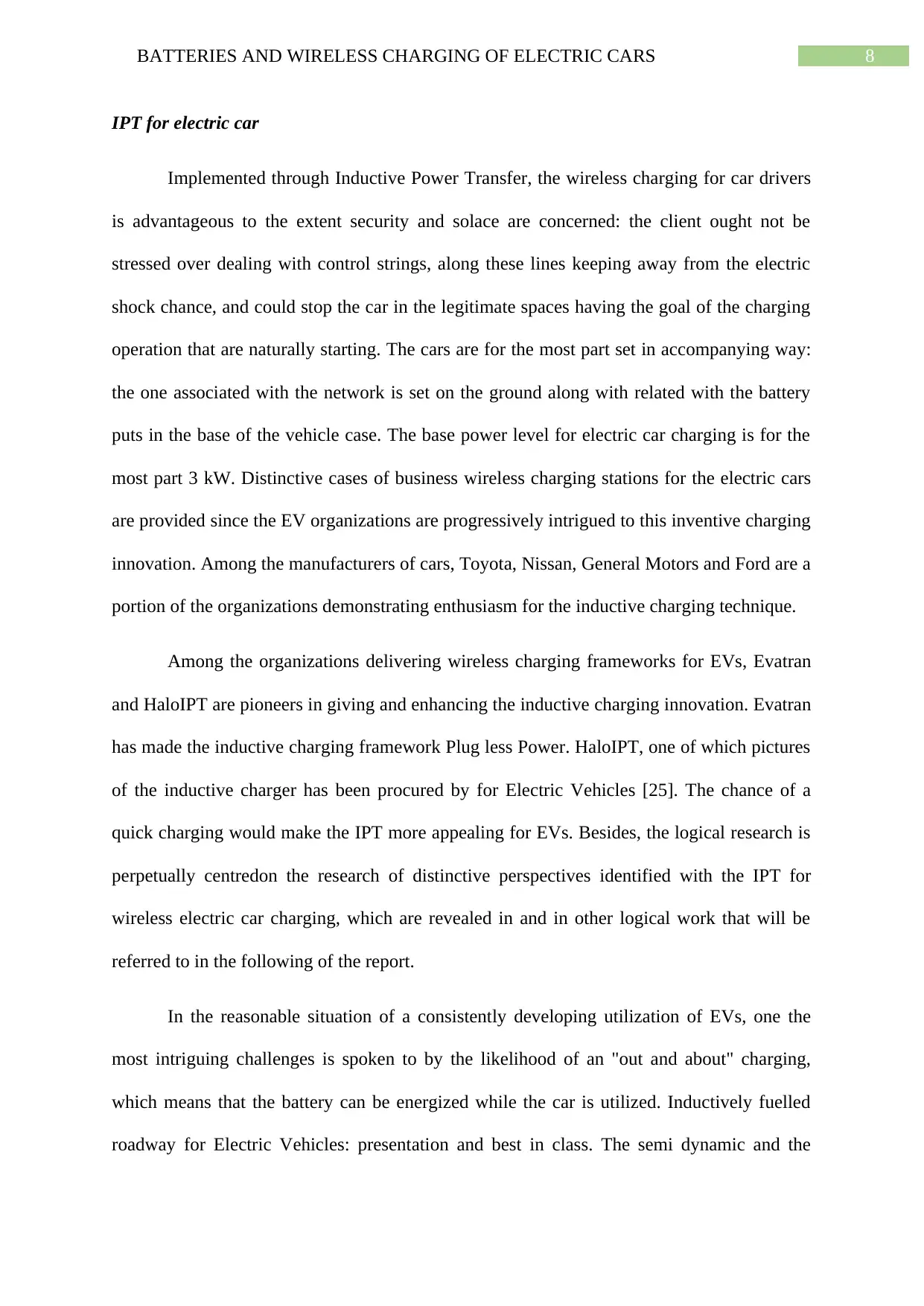
8BATTERIES AND WIRELESS CHARGING OF ELECTRIC CARS
IPT for electric car
Implemented through Inductive Power Transfer, the wireless charging for car drivers
is advantageous to the extent security and solace are concerned: the client ought not be
stressed over dealing with control strings, along these lines keeping away from the electric
shock chance, and could stop the car in the legitimate spaces having the goal of the charging
operation that are naturally starting. The cars are for the most part set in accompanying way:
the one associated with the network is set on the ground along with related with the battery
puts in the base of the vehicle case. The base power level for electric car charging is for the
most part 3 kW. Distinctive cases of business wireless charging stations for the electric cars
are provided since the EV organizations are progressively intrigued to this inventive charging
innovation. Among the manufacturers of cars, Toyota, Nissan, General Motors and Ford are a
portion of the organizations demonstrating enthusiasm for the inductive charging technique.
Among the organizations delivering wireless charging frameworks for EVs, Evatran
and HaloIPT are pioneers in giving and enhancing the inductive charging innovation. Evatran
has made the inductive charging framework Plug less Power. HaloIPT, one of which pictures
of the inductive charger has been procured by for Electric Vehicles [25]. The chance of a
quick charging would make the IPT more appealing for EVs. Besides, the logical research is
perpetually centredon the research of distinctive perspectives identified with the IPT for
wireless electric car charging, which are revealed in and in other logical work that will be
referred to in the following of the report.
In the reasonable situation of a consistently developing utilization of EVs, one the
most intriguing challenges is spoken to by the likelihood of an "out and about" charging,
which means that the battery can be energized while the car is utilized. Inductively fuelled
roadway for Electric Vehicles: presentation and best in class. The semi dynamic and the
IPT for electric car
Implemented through Inductive Power Transfer, the wireless charging for car drivers
is advantageous to the extent security and solace are concerned: the client ought not be
stressed over dealing with control strings, along these lines keeping away from the electric
shock chance, and could stop the car in the legitimate spaces having the goal of the charging
operation that are naturally starting. The cars are for the most part set in accompanying way:
the one associated with the network is set on the ground along with related with the battery
puts in the base of the vehicle case. The base power level for electric car charging is for the
most part 3 kW. Distinctive cases of business wireless charging stations for the electric cars
are provided since the EV organizations are progressively intrigued to this inventive charging
innovation. Among the manufacturers of cars, Toyota, Nissan, General Motors and Ford are a
portion of the organizations demonstrating enthusiasm for the inductive charging technique.
Among the organizations delivering wireless charging frameworks for EVs, Evatran
and HaloIPT are pioneers in giving and enhancing the inductive charging innovation. Evatran
has made the inductive charging framework Plug less Power. HaloIPT, one of which pictures
of the inductive charger has been procured by for Electric Vehicles [25]. The chance of a
quick charging would make the IPT more appealing for EVs. Besides, the logical research is
perpetually centredon the research of distinctive perspectives identified with the IPT for
wireless electric car charging, which are revealed in and in other logical work that will be
referred to in the following of the report.
In the reasonable situation of a consistently developing utilization of EVs, one the
most intriguing challenges is spoken to by the likelihood of an "out and about" charging,
which means that the battery can be energized while the car is utilized. Inductively fuelled
roadway for Electric Vehicles: presentation and best in class. The semi dynamic and the
⊘ This is a preview!⊘
Do you want full access?
Subscribe today to unlock all pages.

Trusted by 1+ million students worldwide
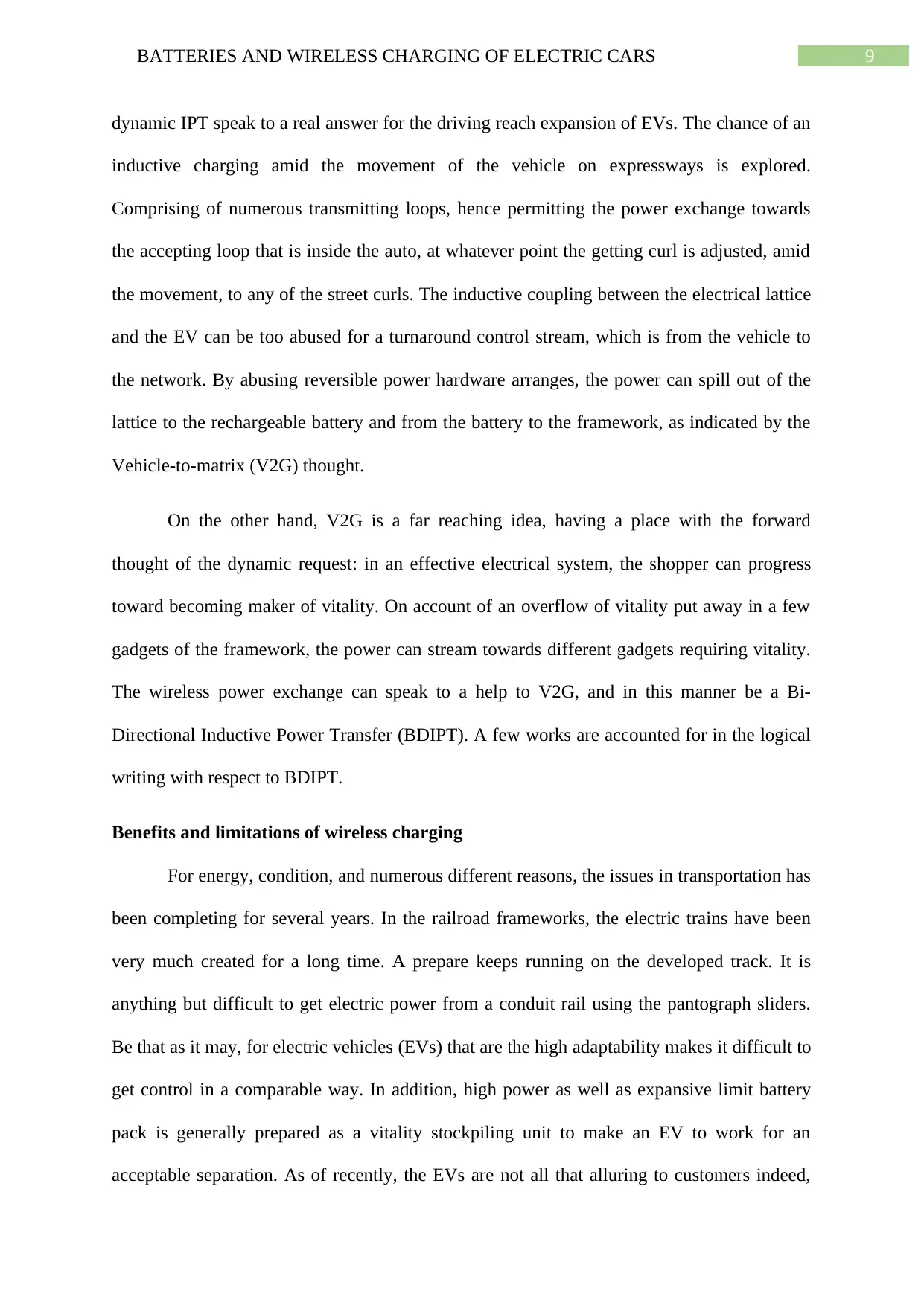
9BATTERIES AND WIRELESS CHARGING OF ELECTRIC CARS
dynamic IPT speak to a real answer for the driving reach expansion of EVs. The chance of an
inductive charging amid the movement of the vehicle on expressways is explored.
Comprising of numerous transmitting loops, hence permitting the power exchange towards
the accepting loop that is inside the auto, at whatever point the getting curl is adjusted, amid
the movement, to any of the street curls. The inductive coupling between the electrical lattice
and the EV can be too abused for a turnaround control stream, which is from the vehicle to
the network. By abusing reversible power hardware arranges, the power can spill out of the
lattice to the rechargeable battery and from the battery to the framework, as indicated by the
Vehicle-to-matrix (V2G) thought.
On the other hand, V2G is a far reaching idea, having a place with the forward
thought of the dynamic request: in an effective electrical system, the shopper can progress
toward becoming maker of vitality. On account of an overflow of vitality put away in a few
gadgets of the framework, the power can stream towards different gadgets requiring vitality.
The wireless power exchange can speak to a help to V2G, and in this manner be a Bi-
Directional Inductive Power Transfer (BDIPT). A few works are accounted for in the logical
writing with respect to BDIPT.
Benefits and limitations of wireless charging
For energy, condition, and numerous different reasons, the issues in transportation has
been completing for several years. In the railroad frameworks, the electric trains have been
very much created for a long time. A prepare keeps running on the developed track. It is
anything but difficult to get electric power from a conduit rail using the pantograph sliders.
Be that as it may, for electric vehicles (EVs) that are the high adaptability makes it difficult to
get control in a comparable way. In addition, high power as well as expansive limit battery
pack is generally prepared as a vitality stockpiling unit to make an EV to work for an
acceptable separation. As of recently, the EVs are not all that alluring to customers indeed,
dynamic IPT speak to a real answer for the driving reach expansion of EVs. The chance of an
inductive charging amid the movement of the vehicle on expressways is explored.
Comprising of numerous transmitting loops, hence permitting the power exchange towards
the accepting loop that is inside the auto, at whatever point the getting curl is adjusted, amid
the movement, to any of the street curls. The inductive coupling between the electrical lattice
and the EV can be too abused for a turnaround control stream, which is from the vehicle to
the network. By abusing reversible power hardware arranges, the power can spill out of the
lattice to the rechargeable battery and from the battery to the framework, as indicated by the
Vehicle-to-matrix (V2G) thought.
On the other hand, V2G is a far reaching idea, having a place with the forward
thought of the dynamic request: in an effective electrical system, the shopper can progress
toward becoming maker of vitality. On account of an overflow of vitality put away in a few
gadgets of the framework, the power can stream towards different gadgets requiring vitality.
The wireless power exchange can speak to a help to V2G, and in this manner be a Bi-
Directional Inductive Power Transfer (BDIPT). A few works are accounted for in the logical
writing with respect to BDIPT.
Benefits and limitations of wireless charging
For energy, condition, and numerous different reasons, the issues in transportation has
been completing for several years. In the railroad frameworks, the electric trains have been
very much created for a long time. A prepare keeps running on the developed track. It is
anything but difficult to get electric power from a conduit rail using the pantograph sliders.
Be that as it may, for electric vehicles (EVs) that are the high adaptability makes it difficult to
get control in a comparable way. In addition, high power as well as expansive limit battery
pack is generally prepared as a vitality stockpiling unit to make an EV to work for an
acceptable separation. As of recently, the EVs are not all that alluring to customers indeed,
Paraphrase This Document
Need a fresh take? Get an instant paraphrase of this document with our AI Paraphraser
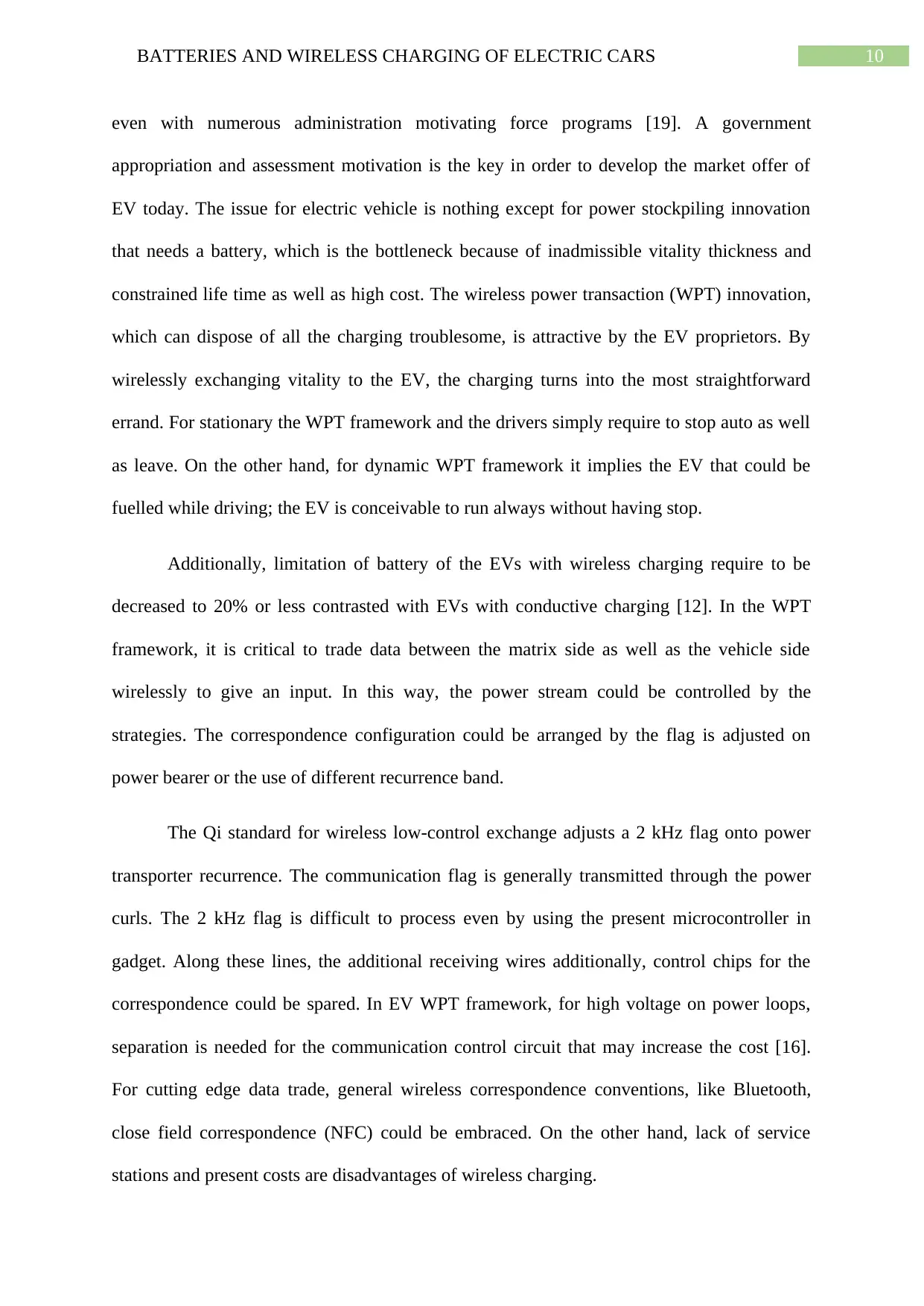
10BATTERIES AND WIRELESS CHARGING OF ELECTRIC CARS
even with numerous administration motivating force programs [19]. A government
appropriation and assessment motivation is the key in order to develop the market offer of
EV today. The issue for electric vehicle is nothing except for power stockpiling innovation
that needs a battery, which is the bottleneck because of inadmissible vitality thickness and
constrained life time as well as high cost. The wireless power transaction (WPT) innovation,
which can dispose of all the charging troublesome, is attractive by the EV proprietors. By
wirelessly exchanging vitality to the EV, the charging turns into the most straightforward
errand. For stationary the WPT framework and the drivers simply require to stop auto as well
as leave. On the other hand, for dynamic WPT framework it implies the EV that could be
fuelled while driving; the EV is conceivable to run always without having stop.
Additionally, limitation of battery of the EVs with wireless charging require to be
decreased to 20% or less contrasted with EVs with conductive charging [12]. In the WPT
framework, it is critical to trade data between the matrix side as well as the vehicle side
wirelessly to give an input. In this way, the power stream could be controlled by the
strategies. The correspondence configuration could be arranged by the flag is adjusted on
power bearer or the use of different recurrence band.
The Qi standard for wireless low-control exchange adjusts a 2 kHz flag onto power
transporter recurrence. The communication flag is generally transmitted through the power
curls. The 2 kHz flag is difficult to process even by using the present microcontroller in
gadget. Along these lines, the additional receiving wires additionally, control chips for the
correspondence could be spared. In EV WPT framework, for high voltage on power loops,
separation is needed for the communication control circuit that may increase the cost [16].
For cutting edge data trade, general wireless correspondence conventions, like Bluetooth,
close field correspondence (NFC) could be embraced. On the other hand, lack of service
stations and present costs are disadvantages of wireless charging.
even with numerous administration motivating force programs [19]. A government
appropriation and assessment motivation is the key in order to develop the market offer of
EV today. The issue for electric vehicle is nothing except for power stockpiling innovation
that needs a battery, which is the bottleneck because of inadmissible vitality thickness and
constrained life time as well as high cost. The wireless power transaction (WPT) innovation,
which can dispose of all the charging troublesome, is attractive by the EV proprietors. By
wirelessly exchanging vitality to the EV, the charging turns into the most straightforward
errand. For stationary the WPT framework and the drivers simply require to stop auto as well
as leave. On the other hand, for dynamic WPT framework it implies the EV that could be
fuelled while driving; the EV is conceivable to run always without having stop.
Additionally, limitation of battery of the EVs with wireless charging require to be
decreased to 20% or less contrasted with EVs with conductive charging [12]. In the WPT
framework, it is critical to trade data between the matrix side as well as the vehicle side
wirelessly to give an input. In this way, the power stream could be controlled by the
strategies. The correspondence configuration could be arranged by the flag is adjusted on
power bearer or the use of different recurrence band.
The Qi standard for wireless low-control exchange adjusts a 2 kHz flag onto power
transporter recurrence. The communication flag is generally transmitted through the power
curls. The 2 kHz flag is difficult to process even by using the present microcontroller in
gadget. Along these lines, the additional receiving wires additionally, control chips for the
correspondence could be spared. In EV WPT framework, for high voltage on power loops,
separation is needed for the communication control circuit that may increase the cost [16].
For cutting edge data trade, general wireless correspondence conventions, like Bluetooth,
close field correspondence (NFC) could be embraced. On the other hand, lack of service
stations and present costs are disadvantages of wireless charging.
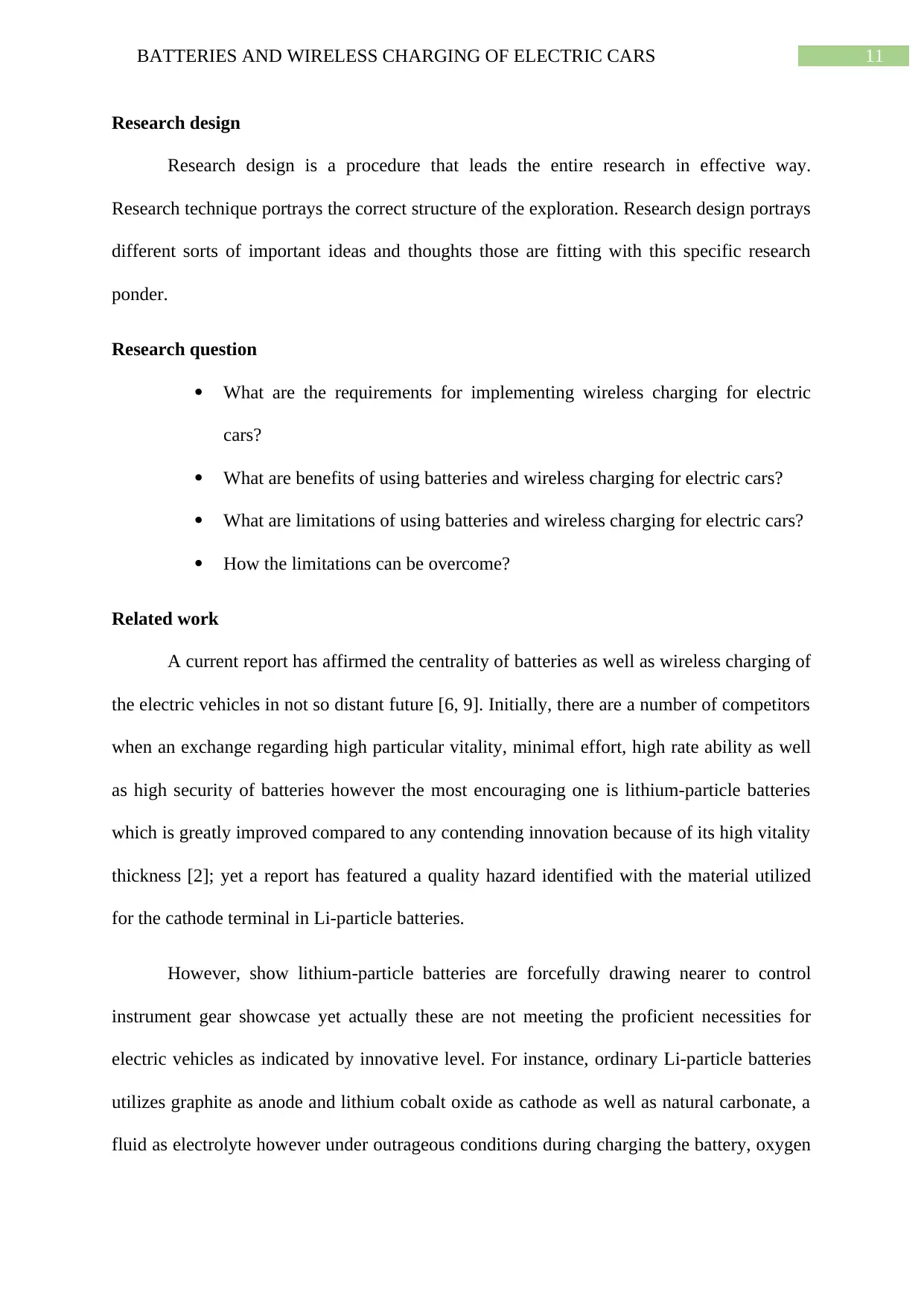
11BATTERIES AND WIRELESS CHARGING OF ELECTRIC CARS
Research design
Research design is a procedure that leads the entire research in effective way.
Research technique portrays the correct structure of the exploration. Research design portrays
different sorts of important ideas and thoughts those are fitting with this specific research
ponder.
Research question
What are the requirements for implementing wireless charging for electric
cars?
What are benefits of using batteries and wireless charging for electric cars?
What are limitations of using batteries and wireless charging for electric cars?
How the limitations can be overcome?
Related work
A current report has affirmed the centrality of batteries as well as wireless charging of
the electric vehicles in not so distant future [6, 9]. Initially, there are a number of competitors
when an exchange regarding high particular vitality, minimal effort, high rate ability as well
as high security of batteries however the most encouraging one is lithium-particle batteries
which is greatly improved compared to any contending innovation because of its high vitality
thickness [2]; yet a report has featured a quality hazard identified with the material utilized
for the cathode terminal in Li-particle batteries.
However, show lithium-particle batteries are forcefully drawing nearer to control
instrument gear showcase yet actually these are not meeting the proficient necessities for
electric vehicles as indicated by innovative level. For instance, ordinary Li-particle batteries
utilizes graphite as anode and lithium cobalt oxide as cathode as well as natural carbonate, a
fluid as electrolyte however under outrageous conditions during charging the battery, oxygen
Research design
Research design is a procedure that leads the entire research in effective way.
Research technique portrays the correct structure of the exploration. Research design portrays
different sorts of important ideas and thoughts those are fitting with this specific research
ponder.
Research question
What are the requirements for implementing wireless charging for electric
cars?
What are benefits of using batteries and wireless charging for electric cars?
What are limitations of using batteries and wireless charging for electric cars?
How the limitations can be overcome?
Related work
A current report has affirmed the centrality of batteries as well as wireless charging of
the electric vehicles in not so distant future [6, 9]. Initially, there are a number of competitors
when an exchange regarding high particular vitality, minimal effort, high rate ability as well
as high security of batteries however the most encouraging one is lithium-particle batteries
which is greatly improved compared to any contending innovation because of its high vitality
thickness [2]; yet a report has featured a quality hazard identified with the material utilized
for the cathode terminal in Li-particle batteries.
However, show lithium-particle batteries are forcefully drawing nearer to control
instrument gear showcase yet actually these are not meeting the proficient necessities for
electric vehicles as indicated by innovative level. For instance, ordinary Li-particle batteries
utilizes graphite as anode and lithium cobalt oxide as cathode as well as natural carbonate, a
fluid as electrolyte however under outrageous conditions during charging the battery, oxygen
⊘ This is a preview!⊘
Do you want full access?
Subscribe today to unlock all pages.

Trusted by 1+ million students worldwide
1 out of 33
Related Documents
Your All-in-One AI-Powered Toolkit for Academic Success.
+13062052269
info@desklib.com
Available 24*7 on WhatsApp / Email
![[object Object]](/_next/static/media/star-bottom.7253800d.svg)
Unlock your academic potential
Copyright © 2020–2025 A2Z Services. All Rights Reserved. Developed and managed by ZUCOL.





